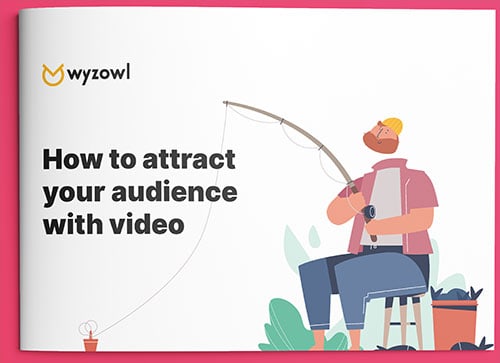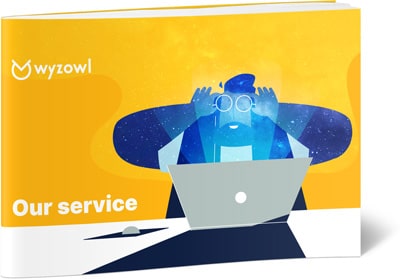There’s a Catalan proverb that says: “By perseverance everything reaches its target.”
It’s a message that will certainly resonate with sales professionals.
Much as we all wish that sales was a linear, straightforward process – the reality is somewhat different.
Particularly in today’s fast-paced, globalised sales environment, it often takes a large number of ‘touches’ to move prospects through the funnel into closed customers.
One tool that’s often mooted as a way to facilitate this process is video: advocates claim it helps people learn about products and services, builds their trust and confidence, overcomes sales objections and diversifies the conversation with interesting, dynamic content.
But what do the numbers say? In summer 2020 we ran a survey of 212 sales and marketing professionals to understand how they use video to support their efforts…
Let’s take a look at what we found!
Audiences ♥ video!
Perhaps the best place to start is the extent to which audiences really love video, and prize it as a tool to learn about products. They also acknowledge that it plays a key role in their decision making-process…
1. 84% of people say that they’ve been convinced to buy a product or service by watching a brand’s video.’
The persuasive power of video is laid bare by this powerful data point. Whether it’s product demos, video ads or explainer videos, the bottom line is that video helps nudge ‘maybe’ into ‘yes’ – an incredibly powerful thing for sales people.

2. 74% of people say they’ve been convinced to buy or download a piece of software or app by watching a video
And it’s not just physical products. If you’re marketing a software product, SaaS business or mobile/web app, around three-quarters of people reckon video has been the overriding catalyst for them to decide to buy or download at some point in the past.

3. When asked how they’d most like to learn about a product or service, two-thirds of people (66%) said they’d prefer to watch a short video.
This compares to 18% who’d rather read a text-based article, website or post, 4% who’d like to view an infographic, 3% who’d rather download an ebook or manual, 3% who’d rather attend a webinar or pitch, and 2% who’d like a sales call or demo.

The power of video as a sales tool
Next, let’s move on to the power of video, specifically, and what it really brings to the sales process.
4. 94% of people feel video is a good way to build confidence during the sales process.
So often, the sales process comes down to building confidence and winning trust. When it comes to online purchases and high-ticket items, this is particularly important. People ultimately don’t want to feel like they’re being ripped off.
So the idea that 94% of people feel that video helps build confidence during the sales process really underscores the value of video here. You could create video content to explain your product or service; you could run through key product benefits. You could produce an in-depth product tour, or invest in video testimonials. You could mix and match these approaches and create a powerful, video-based nurture sequence.
There are so many possibilities. But the bottom line is, you’re going to have a receptive audience who rely on this content to help them feel more confident, removing barriers to sale.

5. 91% of people feel video is a good way to proactively overcome objections in the sales process.
Similarly, we have a powerful stat here around the overcoming of objections. This is Sales 101 stuff – the idea of not waiting for objections to arise during the conversation, but getting in there first, removing those barriers and helping nurture a prospect towards a positive outcome.
Video is a great way to do this, and you can often do it in a really soft but powerful way, with content that’s ostensibly informational. You can create videos around specific topics you find often arise during the sales process, answering questions, offering instructional guides. Just imagine your video starts: “One of the questions we’re often asked is, X…” You have your audience’s attention right away and can remove that objection in a short 1-2 minute video.
And once that asset’s completed, you can overcome that objection time, and time again, for every single lead.

6. 86% of people believe that video content helps their audience feel that they will be supported post-sale.
One thing that’s often overlooked is what pre-sale video says about your brand, and service as a whole.
Companies that invest in compelling, quality content during the nurture process – helping people feel confident and supported – send a subtle, almost subconscious cue to their audience. It says: we’re here for you post-sale, too.
And that’s not just anecdotal. Here, you can see that a massive 86% of people agree.

7. 89% of people believe their business would benefit from using more video in the sales process.
We’ve already touched on the fact that people feel there’s much more companies can do to get sales and marketing working together.
What do people feel that should look like? Well, almost 9 in 10 think that video would be a benefit.

Thanks for reading!
The data in this article puts forward a compelling argument for the power of video as a sales tool.
Overwhelmingly, customers cite video as a tool to help build confidence, learn about products and convince them to take the plunge and buy.
Equally, sales and marketing professionals – while citing real concerns around the alignment between the two functions – reference video as a beneficial tool that helps them overcome objections and facilitate a smooth customer journey.
As the barrier to entry with video content falls ever lower, the message for marketers and salespeople is simple: support each other with video content, and get that needle moving in the right direction!







